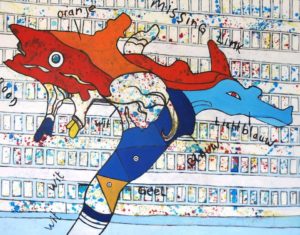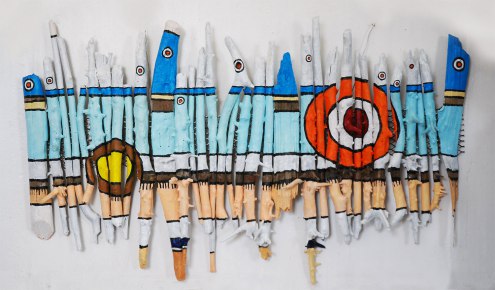
Roddney Tjon Poen Gie
Missing Link.

Zebra.
I saw this sculpture for the first time in a photograph made in Readytex Art Gallery’s space. Lying on the ‘back’ of the sculpture was a woman, apparently dying with laughter. An unusual sight, because as a visitor you’re supposed to view a work of art from a respectful distance. Whoever determined that it should be so, nobody really knows anymore. That is the museum code. That code is held sacred above and beyond any discussion. Or so it seems.
Roddney Tjon Poen Gie (Paramaribo, 1962) is a serious artist, but he doesn’t seem to give much consideration to the code. That can be concluded from the way in which he works. Over ten years ago he made a sculpture on the water’s edge – a Chinese dragon. That sculpture consisted of pieces of scrap wood or drift wood that he found in the surrounding area and attached to existing beach poles. When he was asked some time later what remained of that artwork, he answered laconically, that certain pieces might still exist, but that due to the moisture and the heat such work was inevitably fleeting. The water was the source of inspiration, the water was then also allowed to reclaim it.
That same level-headed mentality explains why his animal sculptures always originate from existing pieces of wood. The shape of that wood determines the identity of the animal. The shape of the wood stimulates his creativity. Although he has a preference for Chinese dragons – he is partly Chinese – , most of his animals look more animal-like or more like fantasy animals, than like anything corresponding to reality. Sometimes it is the way in which he paints them that determines the association that the viewer has with it. I am under the impression that he consciously plays on, or guides, this association with his titles. This sculpture is titled ‘Zebra’, just as logical as it is illogical. Because of the black and white it is, at quick a glance, reminiscent of a zebra, but the shape is completely different from that of a zebra.

Lifeboy.

Seduction

Submurged.
In many of his works the bright colors are what entice the viewer to delve further into them. That is not the case in this work. This work apparently invites the viewer to touch and, as can be seen in the photograph: to use as a type of climbing device.
